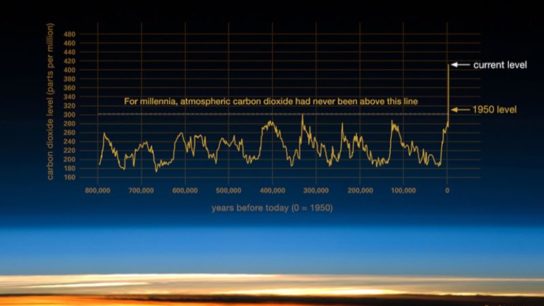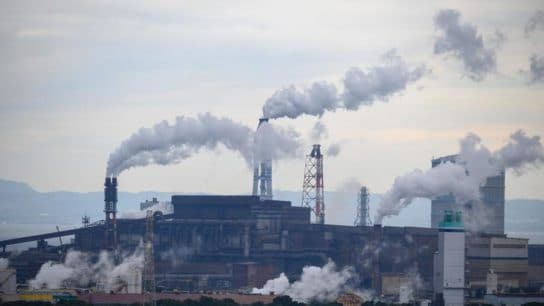Heavy rainfall and overflowing rivers cause frequent floods in Côte d’Ivoire, costing around US $1.2 billion per year. Coastal erosion and sea level rise are set to amplify the damage in the next few decades, and the country must prepare if they are to mitigate this.
Earth.Org has mapped what extreme flooding could look like by 2100 to illustrate the need for action.
—
Sea level rise is occurring faster than the global average around West Africa, menacing under-developed areas with the additional burden of regular flooding. The impacts of such events are many, be it damage to houses, infrastructure and valuable ecosystems, or aquifer and crop contamination with salt water or the propagation of water-borne disease through sewage overflow.
Erosion is also a major factor in determining how fast the ocean reclaims land. Parts of the West African coast have been eroding at a shocking 1.8 m per year as a result of natural and human influences. Sea level rise and regular wave mechanics slowly gnaw away at the shores, but unregulated sand mining and the destruction of natural flood barriers such as mangroves are more deplorable causes.
The city of Abidjan could find some of its critical infrastructures, such as ports and hospitals, inundated and damaged before long, and the construction of a 260 m seawall is unlikely to do much. Temporary respite could come from the nearby Comoe River and Grand Bassam lagoon. The river usually carries large amounts of silt down to the shore and helps prevent erosion, but recently, silt has clogged its outlet into the sea, diverting its water into the lagoon. Attempts have been made to open channels to the ocean, but these are always rapidly filled up again.
Officials have stated that it would cost US $30 million to build a stable canal, which is quite costly for a temporary solution. The urgent need for protection has been brought up with the International Union for the Conservation of Nature (IUCN), and consensus is that natural barriers such as mangroves and coastal dunes may be the best option at the moment.
The lack of longer-term solutions is not reassuring for a country whose capital could face some disastrous flooding by the end of the century. Earth.Org has mapped such an event to illustrate the need for action.

Sea level rise projections by 2100 for two scenarios with the amount of rise in meters indicated (mild = 1m; extreme = 3m). Population displacement indicated bottom right.
Sea level rise mapping methodology
Global mean sea level is projected to rise by 2m at the end of this century. However, in order to determine local sea level rise (SLR), one has to take into account local coastal flood levels which could be 2.8m above Mean Higher-High Water (MHHW) at extreme forecasts. These local levels bring variability to the projected SLR from 1m to 6.5m (eg. Rio vs Kolkata).
The SLR scenarios used in this study are based on the forecasts from Climate Central – Coastal Risk Screening Tool with the following parameters:
- Sea level Projection Source
- Coastal Flood Level
- Pollution Scenario
- Luck
Sea level Projection Source:
From two highly cited journals by Kopp et al., estimating SLR mainly due to ocean thermal expansion and ice melt. The mid-range scenario projected 0.5-1.2m of SLR based on different representative concentration pathways (RCP) defined by the IPCC. While the pessimistic scenario added more mechanisms of ice-sheet melting, estimating SLR at 1m-2.5m in 2100, with a projection of 10m SLR at 2300.
Coastal Flooding
More frequent coastal flooding is a direct impact of sea-level rise. Based on the Global tides and surge reanalysis by Muis et al., (2016), it is estimated that the extreme coastal water level could be from 0.2 – 2.8m over the mean level. While in extreme cases like China and the Netherlands it could experience 5-10m of extreme sea levels. Here, the coastal local flood level is added on top of the projected SLR.
Pollution Scenario:
Allows choosing the RCP, the greenhouse gas concentration trajectory defined by the IPCC. The mild level is based on RCP4.5, of 2°C temperature rise; while the Extreme level is based on RCP 8.5, of 4°C temperature rise.
Luck:
Applies to the baseline SLR, defined in the “Sea level projection” section, upon which we add flooding. “Mild” refers to the mid-range scenario of 0.5-1.2m, and “extreme” to the pessimistic scenario of 1-2.5m. We used the high-end value of each scenario (mild = 1m; extreme = 2.5m).
Mapping by Braundt Lau. Article written by Owen Mulhern.
You might also like: Sea Level Rise by 2100 – Miami
References:
-
Kulp, Scott A., and Benjamin H. Strauss. “New elevation data triple estimates of global vulnerability to sea-level rise and coastal flooding.” Nature communications 10.1 (2019): 1-12.
-
Florczyk, A. J., Corbane, C., Ehrlich, D., Freire, S., Kemper, T., Maffenini, L., Melchiorri, M., Politis, P., Schiavina, M., Sabo, F. & Zanchetta, L. (2019). GHSL Data Package 2019 Public Release.
-
Kopp, R. E., DeConto, R. M., Bader, D. A., Hay, C. C., Horton, R. M., Kulp, S., Oppenheimer, M., Pollard, D. & Strauss, B. H. (2017). Evolving Understanding of Antarctic Ice-Sheet Physics and Ambiguity in Probabilistic Sea-Level Projections. Earth’s Future, 5(12), 1217–1233.
-
Kopp, R. E., Horton, R. M., Little, C. M., Mitrovica, J. X., Oppenheimer, M., Rasmussen, D. J., Strauss, B. H. & Tebaldi, C. (2014). Probabilistic 21st and 22nd Century Sea-Level Projections at a Global Network of Tide-Gauge Sites. Earth’s Future, 2(8), 383–406.
-
Kulp, S. A. & Strauss, B. H. (2019). New Elevation Data Triple Estimates of Global Vulnerability to Sea-Level Rise and Coastal Flooding. Nature Communications, 10(1), 4844. Retrieved June 21, 2020, from http://www.nature.com/articles/s41467-019-12808-z
-
Muis, S., Verlaan, M., Winsemius, H. C., Aerts, J. C. J. H. & Ward, P. J. (2016). A Global Reanalysis of Storm Surges and Extreme Sea Levels. Nature Communications, 7.










![The Statistics of Biodiversity Loss [2020 WWF Report]](https://u4d2z7k9.rocketcdn.me/wp-content/uploads/2020/12/lprwinkyTHB-544x306.jpg)





